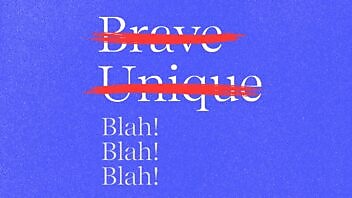Lockdowns, intensive banana bread baking and office shutdowns might be long gone, but COVID has left its mark on the world of work — in the form of a talent crisis. Now, with a recession looming, attracting (and keeping) the best people will dictate how turbulent the next few months will be: Forrester is calling 2023 a “talent-constrained recession”.
In tech especially, talent pipelines are drying up — with fewer applicants per opening and more offers for every accepted one. In the last few months alone, Velocity has worked on three big employer branding projects. We’re expecting to see many more of them in the coming months.
The new pressure — and the changing contract between employers and employees — means that the old recruitment marketing playbook isn’t working any more. So we’ve been applying all the things we’ve learned from our branding and demand generation work to the talent challenge.
The new employer brand playbook
Today, the best employer branding and recruitment marketing looks a lot like the best B2B marketing. We’re re-thinking everything from the Employee Value Proposition and ideal
prospect profiles to the candidate journey and post-hiring loyalty plays — including pipeline KPIs that track engagement, velocity and attribution.
Not surprisingly, more brands are realizing that, in the talent market, your company culture is your product. (In fact, your employer brand might be even more critical than your actual brand — customers might buy despite shitty marketing. No-one joins a company with bad vibes.)
As applicants reassess what the whole “work” thing means for them, their tolerance for bullshit is at an all-time low. They need something to entice them back into the fold. Beyond the obvious pay and benefits packages, that thing might be hard to define, but it’s critical. We’re talking about mojo.
In a sea of “meh”, mojo wins.
Employees want to work somewhere they feel they belong. Not for businesses that describe themselves as one big family before laying off half the workforce.
Belonging isn’t cultivated by buying a bunch of ping pong tables. It’s the culmination of a range of factors like purpose, culture and meaning. It’s the result of packaging and articulating what makes your company a great place to work in a sea of potential employers with very similar offerings.
Belonging is what happens when someone really resonates with the mojo you put into the world.
So how do you achieve that? Well, for a start, here’s what mojo isn’t: rattling off every ingredient in your special sauce to anyone who’ll listen.
Just like the most compelling consumer brands, this is about clarity and confidence. The first step in getting started with your employer brand is to decide who you’re for. And, even more importantly, who you’re not for.
Here are some things to consider for your own employer brand:
1. Get specific with your choices
The best employer brands come from clear choices that build a coherent story designed to attract specific applicants. If you try to be everything to everyone, you’ll be nothing to no one.
So, the first step is to work out who your company is actually for and don’t worry if you alienate the audience who wouldn’t work out in the first place.
This doesn’t need to be hyper-prescriptive — broad strokes are OK.
Case in point: A customer service professional in the world of business banking will find a range of different employer branding strategies within the same sector. At Monzo, they can join a community of talented, creative problem-solvers “to help build the bank of the future”. Starling offers careers that contribute to “radically reshape banking”. These represent small, but fundamental differences in personality. One sounds constructive, the other disruptive.
Tide Business gets even more specific. It refers to its team as “Tideans”, whose collective mission is to “help make running a business effortless for our members”. This feels more community based, with a mission that isn’t quite so grandiose.
Despite small tonal shifts, each sends big signals to the person mulling their next move. Are you building a community or pushing your industry forward? Are you obsessive about your customers or focused on the big picture? These are the choices to triangulate your mojo around.
2. Make your mission critical
Once you’ve put your stake in the ground, you can start thinking about the best way to articulate your mission. The new generation entering the workplace care more about the purpose behind their work than ever. This is getting more important: Peakon’s 2021 Heartbeat Survey found that employees at purpose-driven organizations are 3x more likely to stay.
Almost a quarter of Gen Zers picked their current workplace because of a positive workplace culture and a sense of belonging, while 21% chose their role to derive a sense of meaning from their work.
Plenty of companies espouse the benefits of sustainability and purpose, but what are you actually doing as a brand that matters? Where are you falling short (and what are you working to change)?
You don’t need to have a million-dollar carbon offset program to make good on earnest intent.
Applying for B-Corp status might be a good first move — even progressing an application is a good signal you’re moving in the right direction.
3. Spotlight your weaknesses as well as your strengths
When it comes to employer branding, you’re not always going to get it right straight away. And that’s OK. Transparency around failure is a powerful signal of confidence.
And people are really attracted to confidence. This isn’t about bragging or shouting the loudest, it’s about knowing who you are and what you’re great at — and being self-assured enough to learn in public.
If you’re up-front from the get-go that you’re really good at inclusive working, but the learning curve is steep and it takes a while to earn autonomy, you’re more likely not to shock people when they get started.
Then, hopefully, they’ll be more likely to stick around when they realize you weren’t kidding about people’s calendars looking like a competitive Tetris speedrun.
People respond surprisingly well to a healthy dollop of honesty that signals your mission isn’t just a checkbox exercise. It’s better to show you’re making the right moves towards your goals, rather than blagging about surface-level credentials.
Most applicants, for example, will respond more favorably towards a business that’s honest about its ESG progress and how they’re going to fix it, than one that tries to signal unfounded confidence with a line like “we continually strive to work towards a greener planet.” (And don’t even get us started on wishy-washy words like ‘continually’).
4. Put your people on a pedestal
Even if you feel like what you’re saying is honest and original, the reality is, for employer branding, most businesses can make the same kinds of claims. As in any busy market, the more everyone makes the same claims, how you make those claims becomes your best differentiator.
The first step is to find a voice for your employer brand, which might be more difficult than you first think. Use your customer brand voice as a starting point and then take a look at what needs to change. You might need to go more formal or more fun, more serious or more loose, more compassionate, or more challenging.
The next step is to figure out how to use it. This is much less about execution and more about who it comes from. Often, the best stories emerge most authentically when you let people other than the marketing and HR teams speak. So get your people out there.
Let them tell your story (in their own words). They’ll have surprising, delightful, weird ways of articulating what matters about where they work that signal real-people-work-here (rather than stage-managed-marketing-guff).
This doesn’t mean you need to create a video montage of everyone’s pets (though it couldn’t hurt), but putting your people in the spotlight is the only way to back up what you’re saying.
Without your people, your employer brand is an empty shell of worthless values. No one cares that marketing says the company is brave and unique. You know what’s actually brave? Getting out of the way long enough to hear what everyone else thinks.
Over to you
Next year is going to be critical for employer branding teams. And that gravity can make it hard to get started. But think of this more like a series of campaigns than a big-bang relaunch.
- Surface the assumptions baked into your current employer brand, and then make some clear choices about how well it represents who you are today.
- Refine your mission and find some meaningful focus. Telling the world you’re ‘human-centric’ or ‘curious’, for instance, are pretty vague claims. No applicant is going to be relieved they’ve finally found a company that isn’t for uninterested robots.
- Tighten your Employee Value Proposition – knowing exactly who you’re for and what you offer.
- Think about the whole candidate journey – not just the recruitment ads on LinkedIn and the Careers page on your site. Consider every step from first twinkle to new hire orientation and beyond. Role descriptions are key (but most are boring as hell).
- Iterate in public and pivot based on the results to connect your assumptions to what the market is looking for.
- Interrogate your values and your posture on things job-seekers care about. Be brutally honest about your ESG credentials, and make moves to catch up if you’re behind.
- Experiment with new ways to tell your story and the people that tell it. Put a microphone in front of less-heard voices. It’ll not only help your existing employees feel more connected to where they work, but it’ll attract like-minded folk, too.

Enjoyed this article?
Take part in the discussion








Comments
There are no comments yet for this post. Why not be the first?